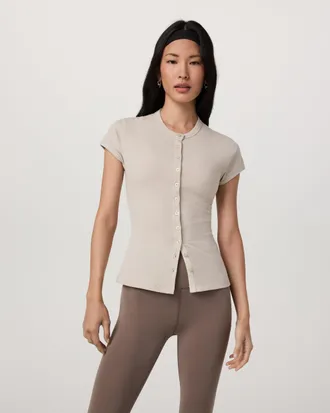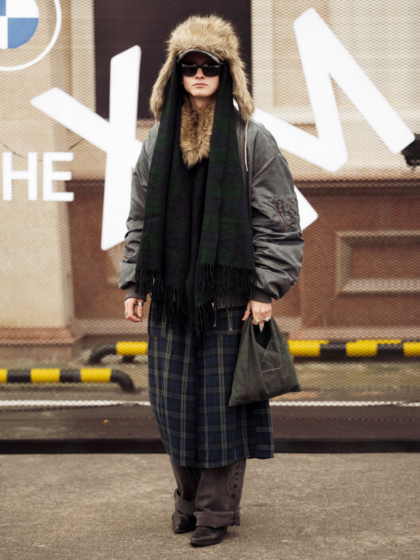Spring Into Better Skin: Your Ultimate Sunscreen Guide
As the temperature rises, so does the desire to have a healthy summer glow. We’re all taught that sunscreen is essential to a good skincare routine, but there are still a ton of myths about how to best protect your skin. For example, did you know that beach umbrellas offer barely any protection against harmful UV rays?
That’s why we’ve created the Ultimate Sunscreen Guide; your new go-to resource for sun safety and education. You’ll find an answer to all your sunscreen-themed burning questions (see what I did there?).
To help with the task, we brought in New York-based dermatologist, Dr. Joshua Zeichner.
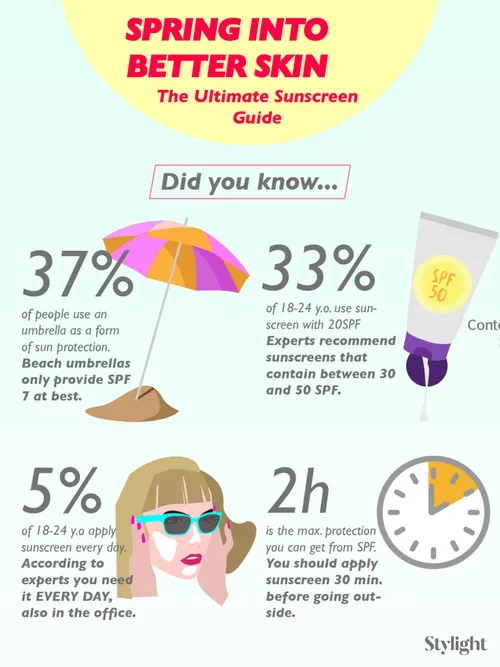
What does SPF mean?
SPF, or Sun Protection Factor, is a measure of how well a sunscreen will protect your skin from UVB rays. The sunlight that reaches us is made up of two types of harmful rays: UVA and UVB. UVA rays penetrate into your skin’s thickest layer, the dermis. Whereas UVB rays tend to burn the superficial layers of your skin.
An easy way to remember the difference is UVA=aging. These rays can lead to premature skin aging and wrinkling.
On the other hand, UVB=burning. UVB rays can play a key role in the development of skin cancer and painful burns.
SPF Numbers explained
The number of SPF is a measure of how long you can stay in the sun. For example, if you wear an SPF 30, you can stay in the sun 30 times longer than you could have if you didn’t apply sunscreen.
“Look for a sunscreen labelled as broad spectrum and an SPF 30 or higher,” says Dr. Zeichner. “This ensures you will get effective protection against UVA and UVB light.”
This magic number doesn’t mean you can spend endless hours in the sun though. In real life, people often don’t apply a thick enough layer of sunscreen and what is applied is often reduced by abrasion, water, and sweat. All these elements lessen the amount of time you can spend in the sun without causing damage to your skin. When it comes to sunscreen application, it’s always better to be on the safe side and apply a little extra!
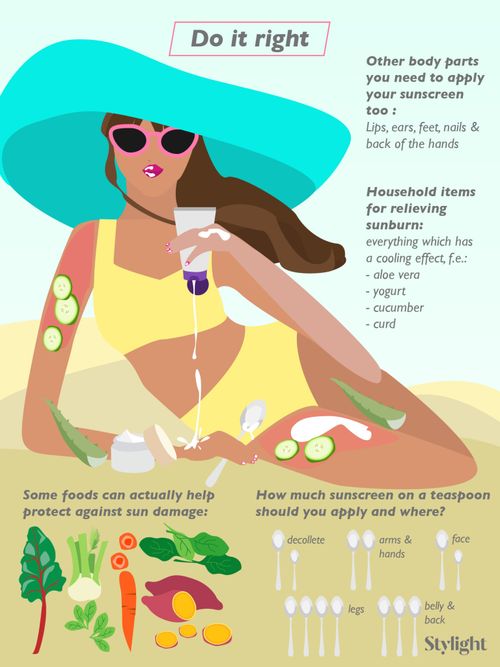
Mineral vs. chemical sunscreen: what are the differences?
Now that we know the basics of SPF, let’s tackle one of the most debated questions: mineral (or physical) vs. chemical sunscreen. What are the differences? Which one is best?
The main difference between the two is the way in which they operate. Mineral sunscreen contains elements like zinc oxide and titanium dioxide, and protects your skin by forming a physical barrier against the sun’s rays. On the other hand, chemical sunscreen allows the UV rays to penetrate the skin, and once they’ve been absorbed it uses ingredients such as oxybenzone, avobenzone, octisalate, octocrylene, homosalate, and octinoxate to create a chemical reaction which converts the harmful rays into harmless heat, which is then dissipated by the skin.
So, which one should you choose? They both have their pros and cons: chemical sunscreen is quick and easy to apply, but might lead to allergic reactions in people with sensitive skin, as well as making conditions like melasma and rosacea worse; mineral sunscreen contains safer ingredients for long-term use and sensitive skins, but often leaves an unappealing “white cast” on the skin, especially on darker complexions.
Overall, one isn’t better than the other (even though some experts tend to recommend mineral sunscreen more), and something is definitely better than nothing!
How much sunscreen should you actually use?
For your face, neck, shoulder, and cleavage areas, aim for around 1-2 teaspoons of sunscreen. Arms and hands require around 2 teaspoons and roughly 4-5 teaspoons for your legs. Your stomach and back need 3-4 teaspoons, and don’t forget your ears and feet! Nobody wants to squeeze bright red toes into socks and shoes.
How does sunscreen fit in your skincare routine?
The order in which you apply your sunscreen is also important. In the morning, sunscreen should come before your moisturiser.
Whether in your daily life, tanning on a beach, or skiing in the Alps: sunscreen first, moisturiser second.
How long does sunscreen actually last?
When talking about shelf life, sunscreens generally last around 36 months from the production date—not from the purchase or opening date. So, according to experts, the actual shelf life of the massive sunscreen bottle you bought on holiday last year is more between 6 and 12 months. If you’re still unsure, the PAO symbol (the one that looks like a jar being opened) on your sunscreen bottle will include a time period, such as “12M,” which means that the product continues to be effective for 12 months after opening.
How often should you reapply sunscreen?
As we talked about earlier, the SPF Number indicates how long your sun protection is effective for. But how often should it be reapplied? Reapplication every two hours is highly recommended—especially when using lower SPF. Additionally, you should reapply SPF more regularly if you are exercising or swimming, as perspiration and water can quickly reduce protection. Reapplying so often when you’re out and about can be inconvenient, but that’s what sunscreen sticks are for! Chuck one in your purse for quick, mess-free reapplication.
Sun protection and diet
Turns out, your grocery list can have a positive impact against sun damage.
Foods high in beta-Carotene have been proven to have a supporting effect in skin protection. Vegetables like carrots, sweet potatoes, fennel, and dark leafy greens are not only good for your diet, but your skin too!
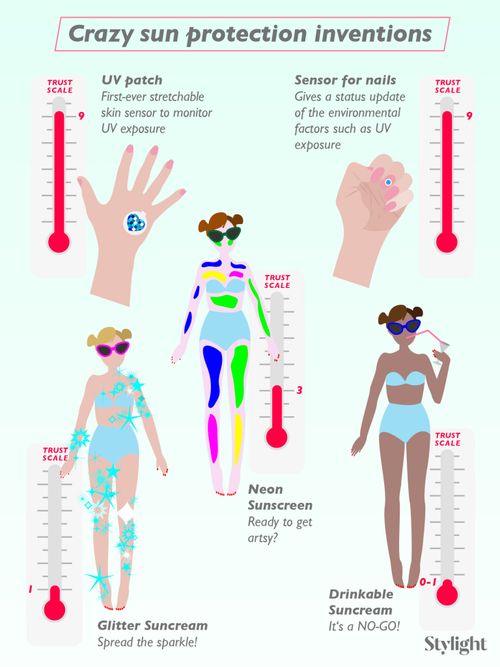
Sunscreen = First defence against wrinkles
Stylight surveyed 300 people and found that only 8% of respondents use sunscreen every day. According to Dr. Zeichner, “sun protection on a daily basis” should be your first form of defence against premature wrinkles and ageing skin.
In addition to sunscreen, “Retinol is the best ingredient we have over the counter to improve the appearance of fine lines and wrinkles. This vitamin A derivative helps stimulate collagen to strengthen the skin foundation. It improves skin tone, texture, and wrinkles.”
How often should I get my skin checked for moles and skin cancer?
Regardless of whether or not you’ve been a slave to the tanning bed, Dr. Zeichner recommends that patients have “a total body skin check for atypical moles and skin cancers once per year“, or more frequently if you have a personal or family history of skin cancer.

Alo
| Glow Sweatband (2-Pack) in Black/White
$48.00
Alo Yoga

Alo
| Uplifting Yoga Block Mat in Smoky Quartz/Silver Brown
$34.00
Alo Yoga
Original text: Kayla Kuefler
Updated text and content: Emma Trimboli




